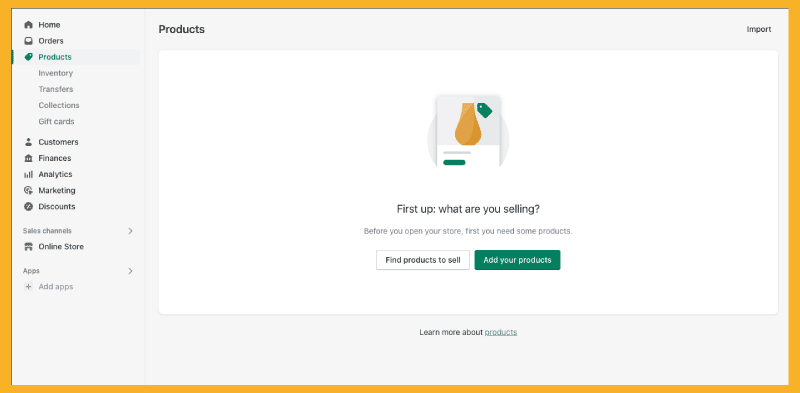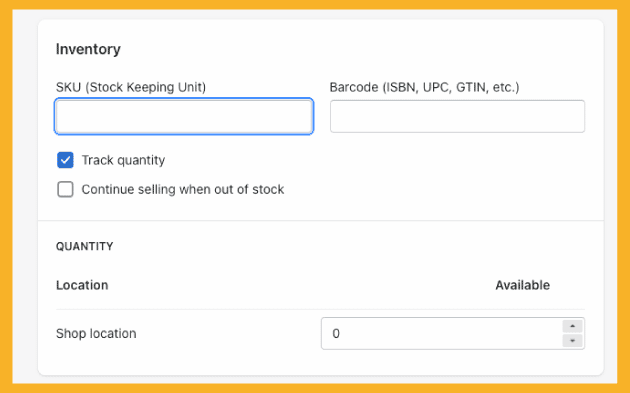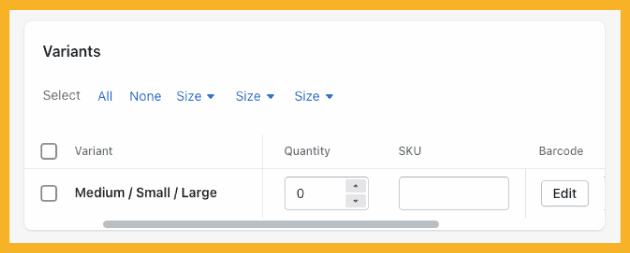Running an ecommerce business requires efficient processes, especially on a platform like Shopify with millions of users.
According to statistics, over 6 million sites currently use Shopify to run their online stores.
One process you should know is using the SKU to track your inventory.
The question: What is SKU in Shopify?
If you want more information, you’ve come to the right place.
I wrote this article to teach you everything you need to know about the SKU code system and how to use it when tracking different products on your online store.
What Is SKU in Shopify?

SKU stands for Stock Keeping Unit.
It’s a unique identifier assigned to products (including product variants).
An online merchant uses the SKU system to identify and track inventory for their ecommerce store.
A Shopify SKU is a unique code with numbers and letters that you assign to products on your Shopify website. They help you identify product details of items in your online store.
An SKU can help you monitor the characteristics of your products.
Here are the most common elements that shop owners mark with SKU codes.
- Manufacturer
- Brand
- Styles
- Sizes
- Color
- Product details
- Pricing
- Product code
- Product variant code
- Categories

When using Shopify to sell products, you can use your own SKU format to streamline processes and track inventory across all your retail stores. Doing so can prevent the following issues:
- Running out of in-demand stock
- Mixing up orders
- Sending the wrong item to a customer
- Losing track of inventory
Having your own product SKU system helps you accurately account for every unit of product you offer on your Shopify store.
A stock-keeping unit (SKU) differs from a model number.
SKUs are unique codes that online sellers use for inventory management. However, you can assign model numbers as part of your SKU number or code.
Where Do Businesses Use a Stock Keeping Unit?

Businesses use stock-keeping unit (SKU) codes to identify and track the inventory of the following areas:
- Retail stores
- Online stores
- Warehouses
- Printed catalogs
- Online catalogs
- Fulfillment centers
- Other places that need inventory management and tracking
How To Create SKU Codes for Shopify

Follow these steps to create unique SKUs for each Shopify product (and product variant).
Create a Code With a Fixed Format.
Creating an SKU format with a fixed order is essential. I recommend using stock-keeping unit codes starting with letters instead of numbers to simplify tracking.
Separate the letters in your code from the numbers with a dash. Then follow up your letter combination with a number sequence.
Here are some examples:
- SKU-1111
- SKU-1112
- SKU-1113
- SKU-1114
- SKU-1115
As you can see, the ascending order of the numbers makes them easy to track.
Avoid using the number 0 in your SKU because other people may confuse it with an O.
Using Automatic SKU Generators
A tool that automatically generates SKUs can be valuable.
Many tools are available for ecommerce businesses, warehouses, and dropshipping businesses.
Here are some examples you should check.
Determine How Many Codes You’ll Need.

The more extensive your product list, the more SKU numbers you’ll need. Thus, retail stores or online stores with extensive inventories might need more extended codes.
However, the rule of thumb is to keep your Shopify SKU codes as short as possible to make them easier to read and understand.
If your SKU codes are too long or complex, they won’t be human-readable and may cause inventory management issues.
Add Your SKU Codes to Your Online Store.
Follow these steps to add SKU codes to your Shopify store.
1 – Log into your Shopify admin dashboard.
2 – Click the Products menu item on the left side of the page.
3 – On the Products page, add a new product, then scroll down until you see the Inventory section of the product page.

4 – Add your code inside the SKU input box.
5 – Click Save.
Follow these steps when adding or editing an existing product’s SKU code.
1 – Go to the Products page on your Shopify admin dashboard.
2 – Look for the existing product you want to edit.

3 – Scroll down to the Inventory section and add or change the SKU code in the input box.
Add SKUs to Product Variants
If your product has separate variants, add unique SKUs to each one.
Head to the variants section and add the SKUs next to each.

SKU Rules To Remember
Remember that your product SKUs must be unique.
While Shopify doesn’t ban duplicate SKUs, you still want each SKU to be different for the price and inventory details to automatically update when customers order products.
Does Shopify Show SKU on the Product Page?

Shopify doesn’t show an SKU on product pages by default.
You’ll need a developer to show SKUs on product pages because you’ll have to alter your theme’s code.
What’s the Difference Between SKU and UPC?
You might have heard barcodes and UPC codes (UPCs) appearing on product packaging.
There are some similarities between UPCs and SKU codes, but they have different functions.
UPC stands for Universal Product Code. It’s a general identifier that businesses share throughout their chain.
UPCs can be the same across various touch points, but SKUs can vary for a supplier, merchant, or reseller.
Global Standards 1 US (GS1 US), an external organization for information standards, assigns UPCs.
However, you can generate your own SKUs without submitting the codes to GS1 US.
How an SKU Code Looks on Printed Labels
Adding an SKU code to a printed label is an excellent practice when running an online store or ecommerce business.
It’s not necessary, but it provides your customers with another way of tracking their orders.

When you print labels for your Shopify orders, the unique code or SKU number appears on top of the bar code.
The Best Practices for SKU Codes on Shopify

Improve your SKU tracking and streamline the identification of stock-keeping units with the following techniques.
1 – Mark products and product descriptions with your code. The first letter can be the first letter of the product type, then the color. If you’re creating an SKU code for blue men’s sneakers, the unique code could be “MSB-115.”
2 – Group SKUs by similarities. If you’re selling T-shirts, it’s better to identify them by color. For example, plain women’s shirts in blue, pink, white, and red could have these SKU codes.
- PWB-111
- PWP-112
- PWW-113
- PWR-114
3 – Avoid using the same letter in one code.
4 – Don’t use special characters.
5 – Order your SKU numbers and codes according to importance.
The Bottom Line
I hope my guide has provided enough information for you to understand stock-keeping units.
Don’t hesitate to use the tips I mentioned when implementing your own system of SKUs.
Remember that SKU management is essential because it helps streamline your operations, even though it isn’t the most exciting part of running your ecommerce business.






